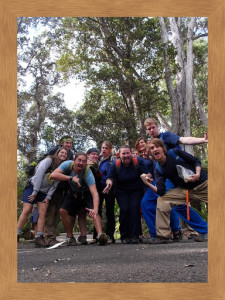By McLean Eames, Experiential Education Supervisor
 The Young Adult students recently explored new parts of the island and helped to clean up their local neighborhood. The group traveled north 40 miles up the Hamakua Coast to Kalopa State Park. The park is a Forest Reserve that protects 615 acres of native Hawaiian forest at 2000’ elevation. Local residents advocated for the land to be set aside as more and more of the Hawaiian landscape was being cleared for Cattle and Sugar Cane operations in the early 1900s. Since then, the Youth Conservation Corps, local school groups, and State Park employees have worked to maintain the Reserve as a rare, mostly native (endemic or indigenous) representation of trees, shrubs, ferns and other forms of life that were already present on the islands before the Polynesians discovered and colonized them. When the group arrived, the first stop was to explore the Polynesian canoe plant garden that was planted and is still maintained by local youth groups. The students recognized many of the plants from the garden back at Reeds Bay. In the garden the students saw creative methods of growing ‘uala (Hawaiian purple potato), large specimens of wauke (paper mulberry) and many other plants that the Hawaiians brought with them for food, medicine, clothing and shelter. One of the students suggested the group take a moment to experience the silence of the forest. With that sentiment in mind, the group set out on a silent hike, where students saw 15’ diameter Ohia trees, nurse logs and many different fern species.
The Young Adult students recently explored new parts of the island and helped to clean up their local neighborhood. The group traveled north 40 miles up the Hamakua Coast to Kalopa State Park. The park is a Forest Reserve that protects 615 acres of native Hawaiian forest at 2000’ elevation. Local residents advocated for the land to be set aside as more and more of the Hawaiian landscape was being cleared for Cattle and Sugar Cane operations in the early 1900s. Since then, the Youth Conservation Corps, local school groups, and State Park employees have worked to maintain the Reserve as a rare, mostly native (endemic or indigenous) representation of trees, shrubs, ferns and other forms of life that were already present on the islands before the Polynesians discovered and colonized them. When the group arrived, the first stop was to explore the Polynesian canoe plant garden that was planted and is still maintained by local youth groups. The students recognized many of the plants from the garden back at Reeds Bay. In the garden the students saw creative methods of growing ‘uala (Hawaiian purple potato), large specimens of wauke (paper mulberry) and many other plants that the Hawaiians brought with them for food, medicine, clothing and shelter. One of the students suggested the group take a moment to experience the silence of the forest. With that sentiment in mind, the group set out on a silent hike, where students saw 15’ diameter Ohia trees, nurse logs and many different fern species.
After the hike, the group traveled a couple of miles past the town of Honoka’a to nearby Waipi’o Valley and enjoyed a picnic lunch at the overlook. Some students recognized the valley from the opening helicopter shots in the movie Jurassic Park! As students looked down into the valley, Reeds Bay Land Supervisor, Mac, pointed out the taro fields that residents care for in the old Hawaiian style–diverting the natural water flow into flooded fields called Lo’i Kalo.